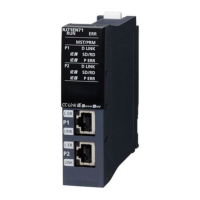196
5 FUNCTIONS USED WITH SSCNET COMMUNICATION
5.5 Driver Communication Function
Advanced synchronous control
• The master axis can be set to the servo input axis, or the output axis.
• When the slave axis is set to the servo input axis, set "[Pr.300] Servo input axis type" to "2: Real current value", or "4:
Feedback value". When set to anything else, the slave axis does not operate as input axis.
• Do not set the slave axis to output axis. When the slave axis is set to output axis, the position commands to the servo
amplifier become invalid.
Motion dedicated PLC instruction
Do not execute the following Motion dedicated PLC instructions for slave axis. When executed they become invalid.
• M(P).SVST/D(P).SVST (Start request of the specified servo program)
• M(P).SVSTD/D(P).SVSTD (Direct positioning start request)
• M(P).CHGV/D(P).CHGV (Speed change request of the specified axis)
Motion SFC program
Do not execute the following instructions for slave axis. When executed they become invalid.
• CHGV (Speed change request)
• CHGP (Target position change request)
Control mode of master axis
The control mode of the master axis can switch between position control mode, speed control mode, and torque control
mode. For the master axis, when a switch to continuous operation to torque control mode is executed, there is a warning
(error code: 09E8H), and the control mode does not switch.
Control mode of slave axis
• Because the slave axis is always controlled by torque mode, the control mode (b2, b3) of "[Md.108] Servo status1 (R:
D32032+48n/Q: #8010+20n)" is in torque control mode ([0, 1]).
• Do not operate slave axis by speed-torque control. For the slave axis, when a control mode switch is executed, or is
operated by speed-torque control, the speed-torque control commands become invalid.

